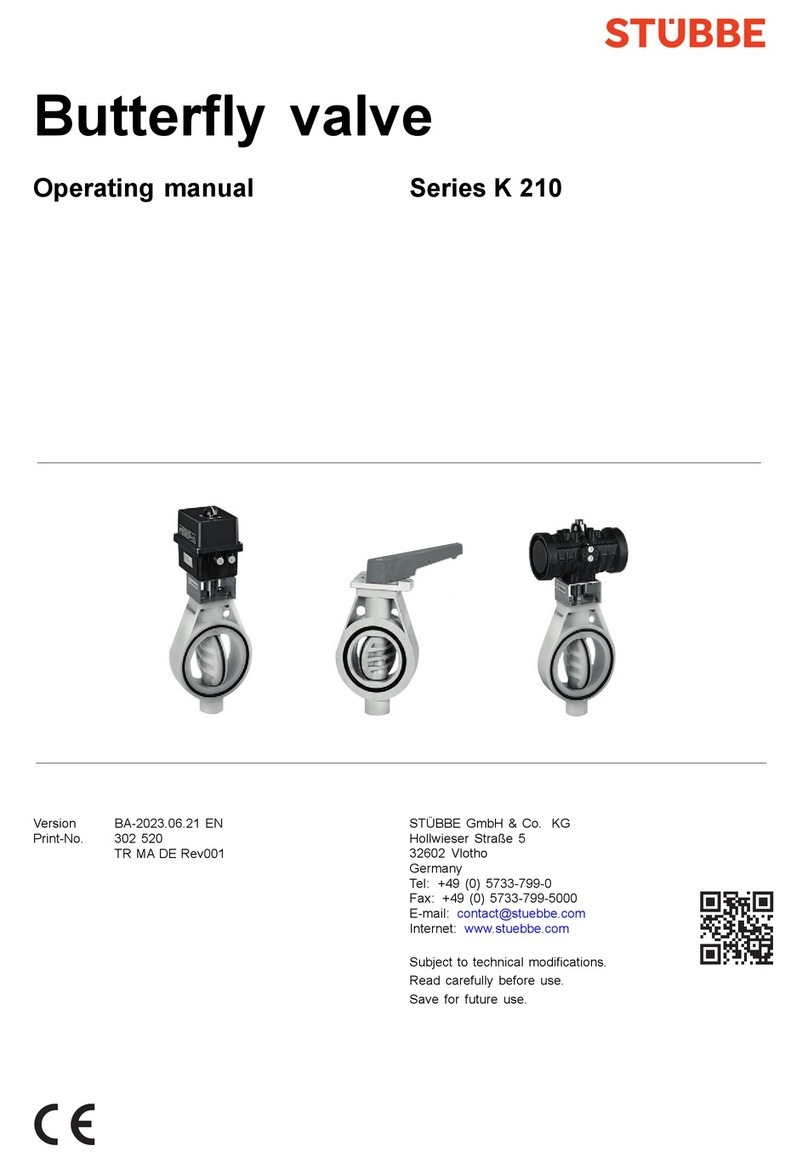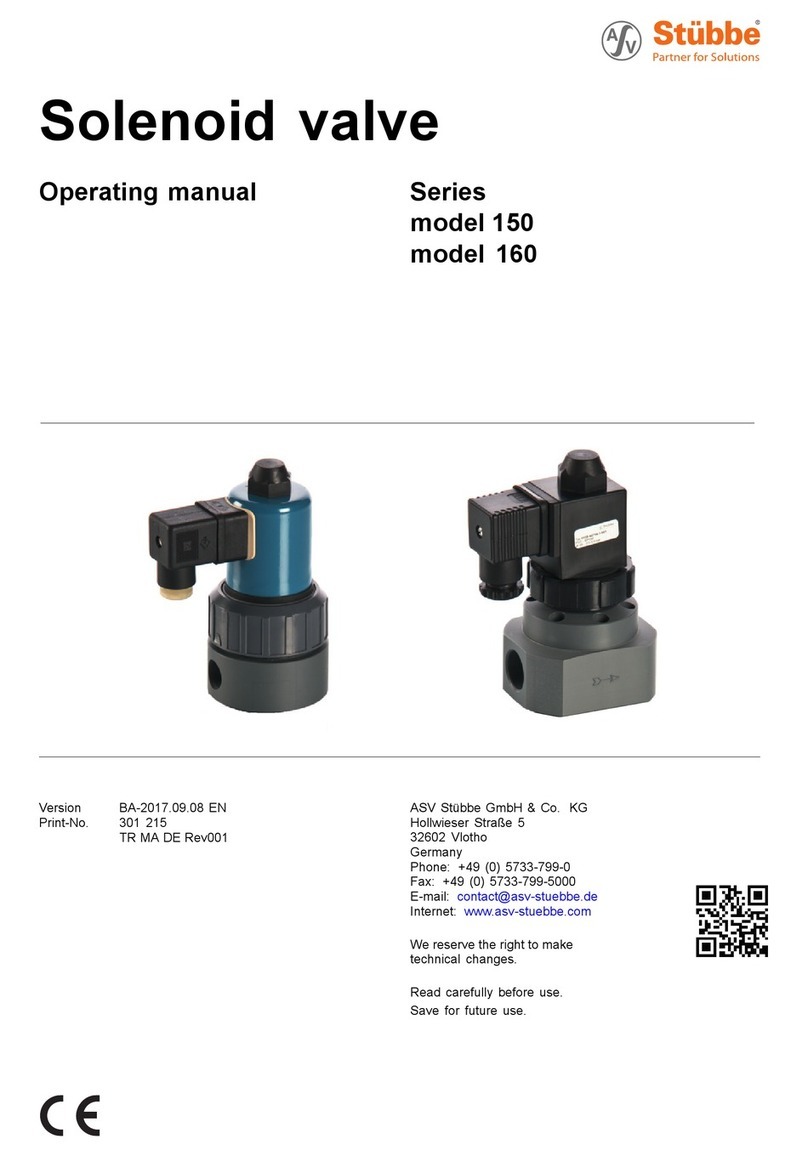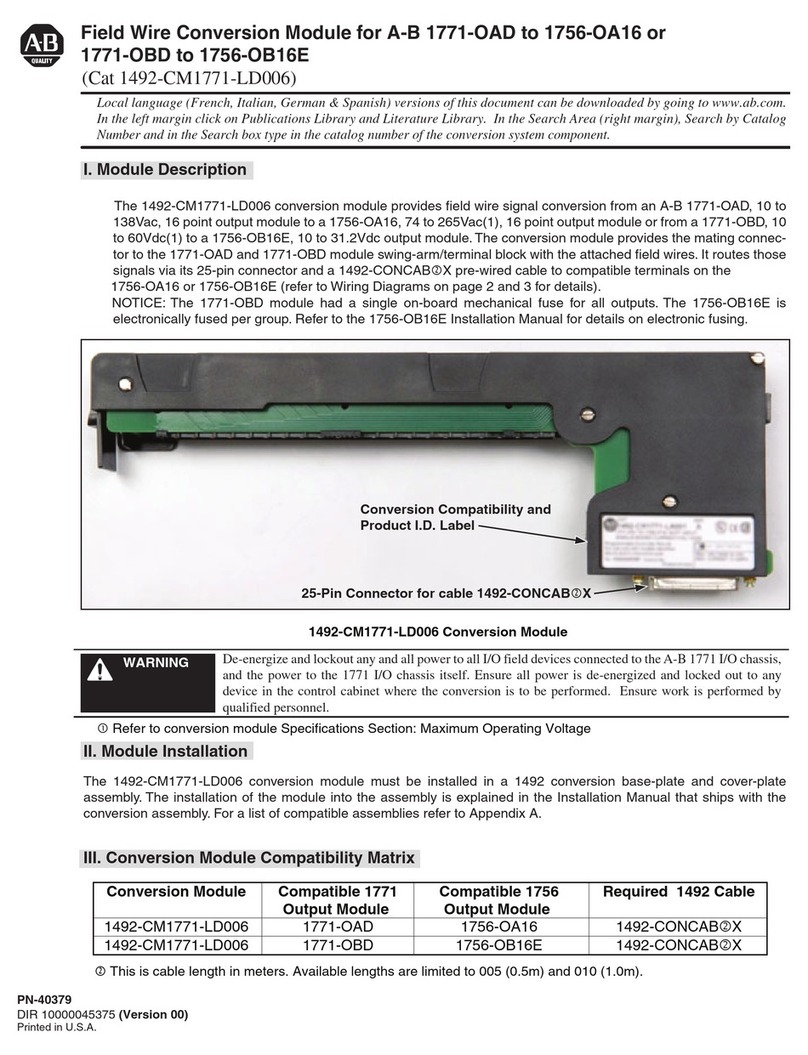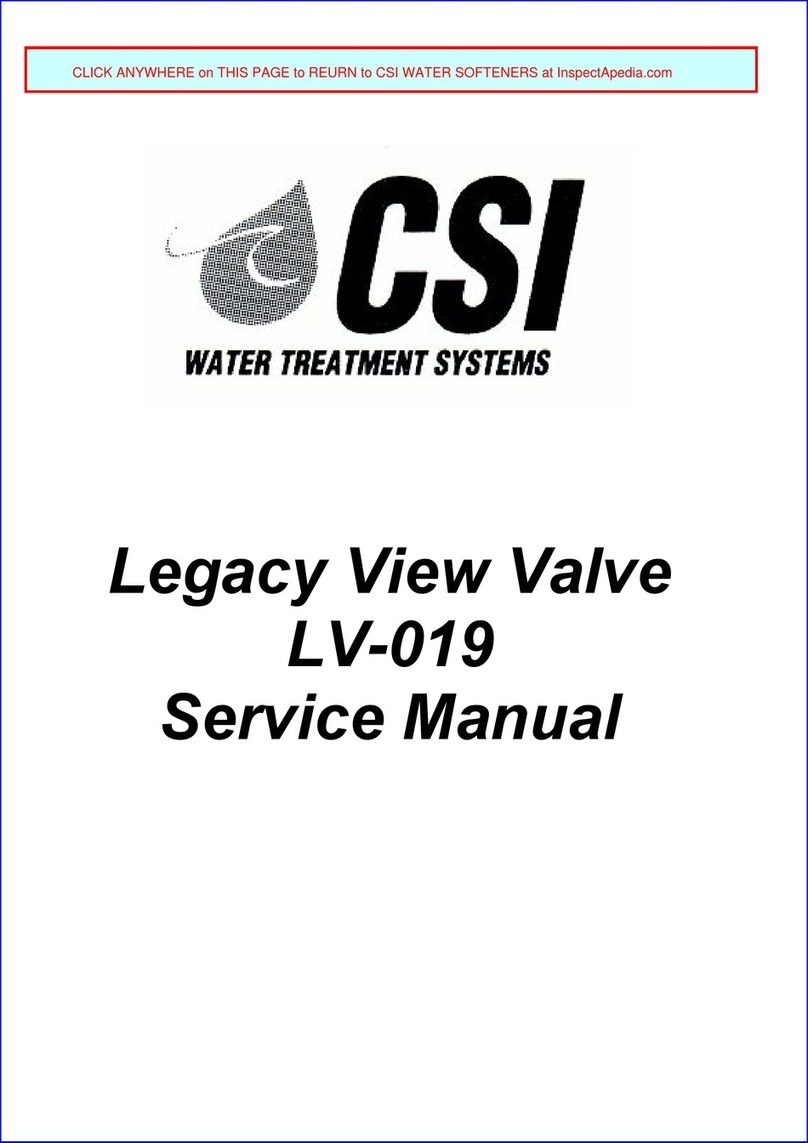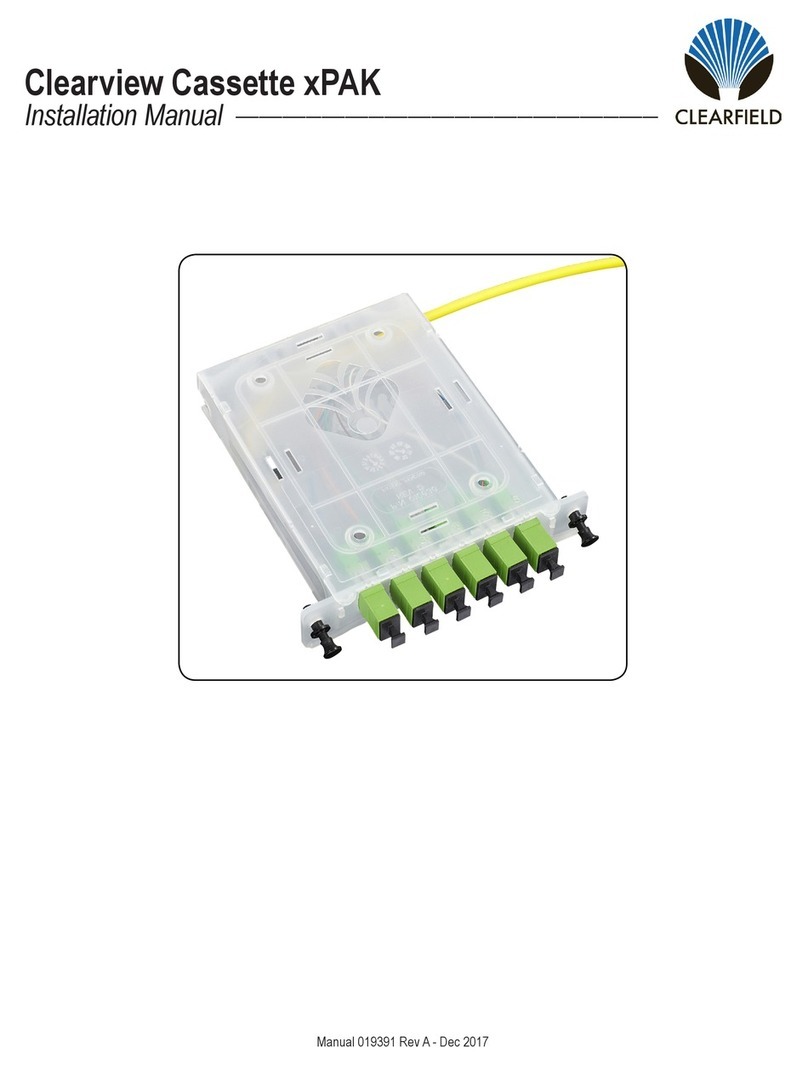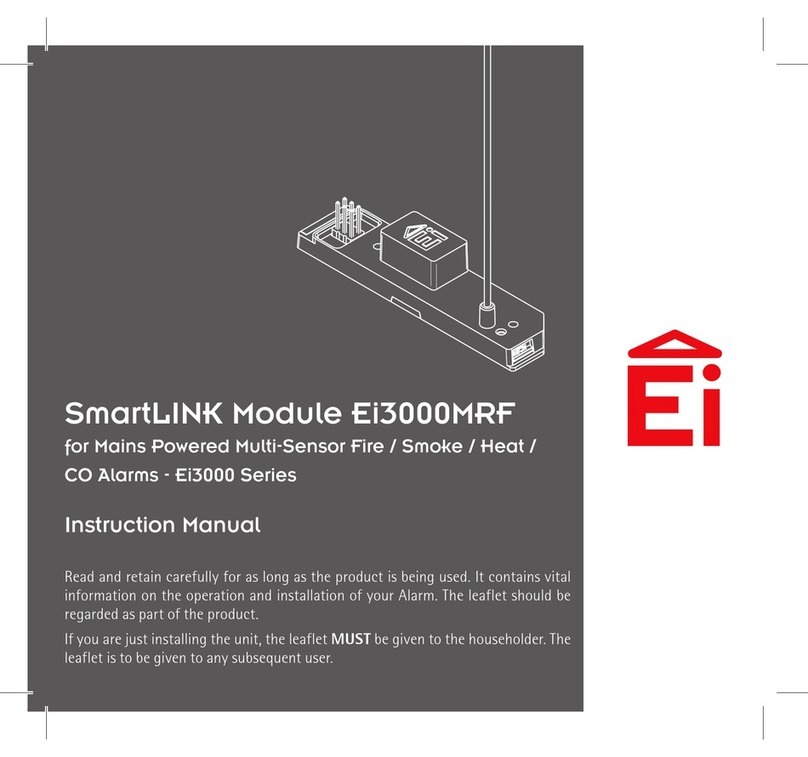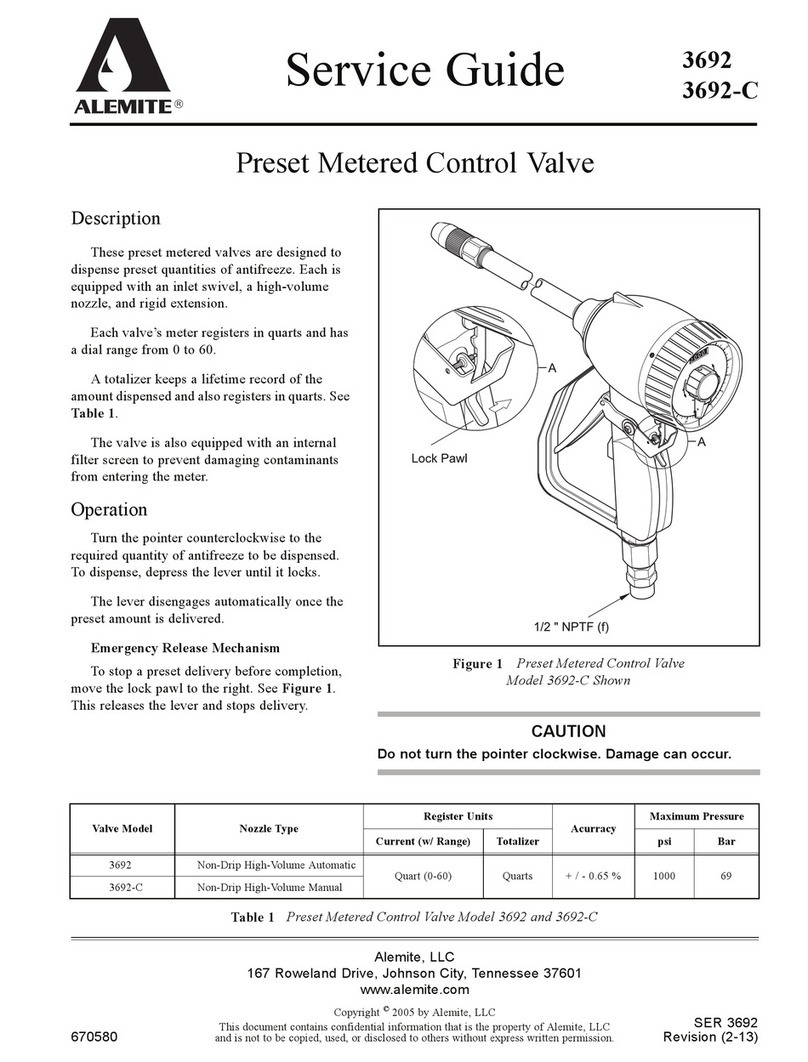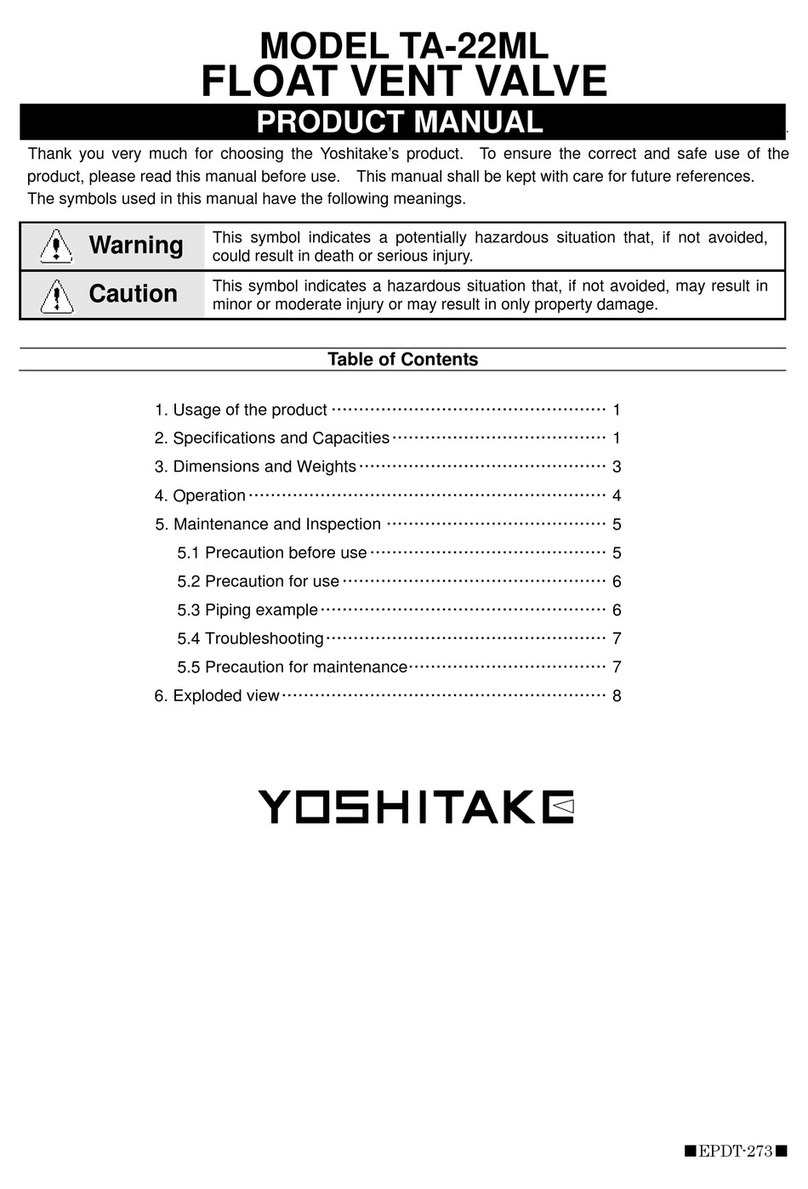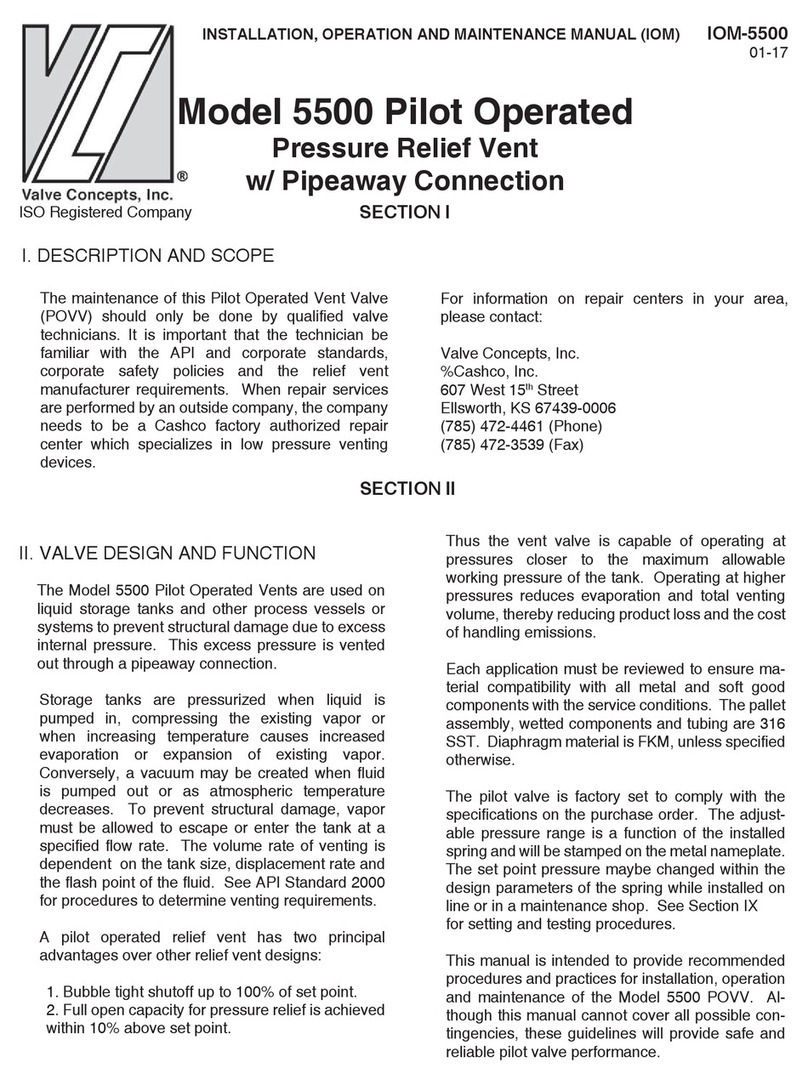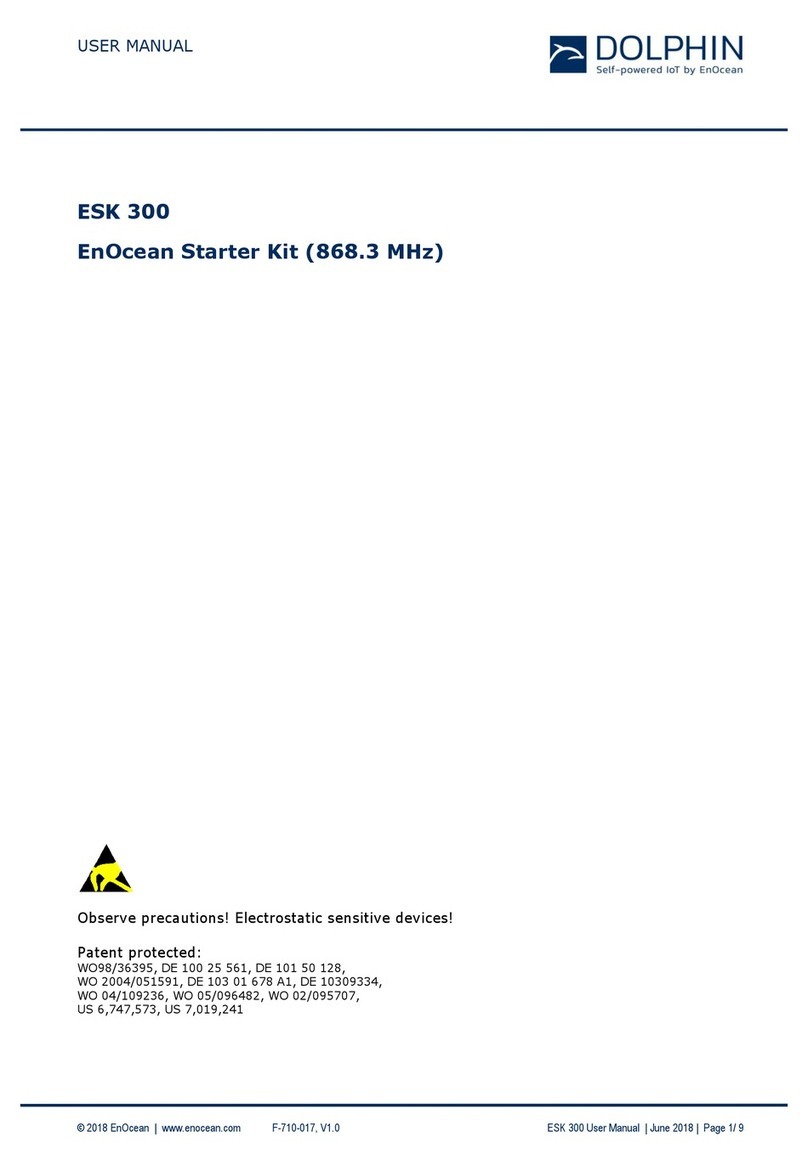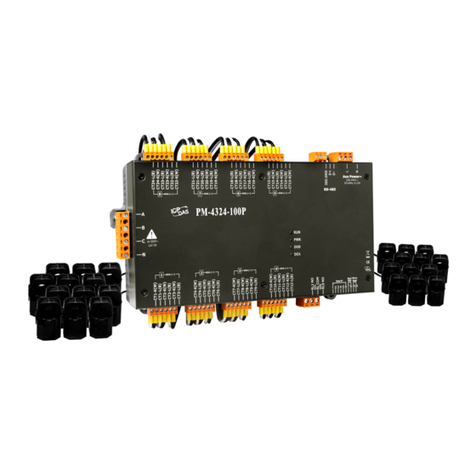Stübbe 6014 Series User manual

Pilot solenoid
valve 6014
Operating manual Series
type 6014
Version BA-2017.10.18 EN
Print-No. 301 302
TR MA DE Rev001
ASV Stübbe GmbH & Co. KG
Hollwieser Straße 5
32602 Vlotho
Germany
Phone: +49 (0) 5733-799-0
Fax: +49 (0) 5733-799-5000
E-mail: [email protected]
Internet: www.asv-stuebbe.com
Subject to technical modifications.
Read carefully before use.
Save for future use.

Table of contents
Table of contents
1 About this document ............................... 3
1.1 Target groups ................................. 3
1.2 Other applicable documents ................ 3
1.3 Warnings and symbols ....................... 3
2 General safety instructions ....................... 4
2.1 Intended use .................................. 4
2.2 General safety instructions .................. 4
2.2.1 Obligations of the operating company . .... . 4
2.2.2 Obligations of personnel ..................... 4
2.3 Specific hazards .............................. 4
2.3.1 Hazardous media ............................ 4
3 Layout and Function ............................... 5
3.1 Name plate ................................... 5
3.2 Description .................................... 5
3.3 Assembly ..................................... 5
3.4 Direction of flow .............................. 5
4 Transport, Storage and Disposal ................. 6
4.1 Unpacking and inspection on delivery . . . . . . 6
4.2 Transportation ................................ 6
4.3 Storage ....................................... 6
4.4 Disposal ....................................... 6
5 Installation and connection ....................... 7
5.1 Check operating conditions ................. 7
5.2 Installing the pilot solenoid on the pneumatic
valve .......................................... 7
5.3 Connect fitting to electrical system .. . .. .. . . 7
6Operation............................................ 8
6.1 Commissioning ............................... 8
6.2 Manual operation ............................. 8
7 Maintenance ......................................... 8
7.1 Servicing ...................................... 8
7.2 Maintenance .................................. 8
7.2.1 Removing fitting .............................. 9
7.3 Replacement parts and return .............. 9
8 Troubleshooting .................................... 10
9 Appendix ............................................. 11
9.1 Technical specifications ...................... 11
9.1.1 Working pressure ............................ 11
9.1.2 Pressure and temperature limits .. .. . . . . . .. 11
9.1.3 Tightening torques ........................... 11
9.2 Circuit diagram ............................... 11
9.3 Plug assignment ............................. 11
List of figures
Fig. 1 Name plate (example) ....................... 5
Fig. 2 Assembly ..................................... 5
Fig. 3 Direction of flow (example) .................. 5
Fig. 4 Installing the pilot solenoid on the pneumatic
valve .......................................... 7
Fig. 5 Manual operation ............................. 8
Fig. 6 NC circuit diagram (closed when
de-energized) ................................. 11
Fig. 7 Connector plug ............................... 11
List of tables
Tab. 1 Other application documents, purpose and
where found .................................. 3
Tab. 2 Warnings and symbols ....................... 3
Tab. 3 Troubleshooting .............................. 10
Tab. 4 Tightening torques ........................... 11
2 type 6014 BA-2017.10.18 EN 301 302

About this document
1 About this document
This manual
• ispartofthefitting
• applies to all series referred to
• describes safe and proper operation during all operating
phases
1.1 Target groups
Operating company
• Responsibilities:
– Keep this manual available at the place of operation,
also for future use.
– Ensure that employees read and observe this manual
and other applicable documents, especially the safety
instructions and warnings.
– Observe any additional country-specific rules and reg-
ulations that relate to the system.
Qualified personnel, fitter
• Mechanics qualification:
– Qualified employees with additional training for fitting
the respective pipework
• Electrical qualification:
– Qualified electrician
• Responsibility:
– Read, observe and follow this manual and the other
applicable documents, especially all safety instructions
and warnings.
1.2 Other applicable documents
To download:
Type 6014 data sheet
Technical data and conditions of
operation
www.asv-stuebbe.de/pdf_datasheets/301296.pdf
To download:
CE declarationofconformity
Conformity with standards
www.asv-stuebbe.de/pdf_DOC/301310.pdf
Tab. 1 Other application documents, purpose
and where found
1.3 Warnings and symbols
Symbol Meaning
• Immediate acute risk
• Death, serious bodily harm
• Potentially acute risk
• Death, serious bodily harm
• Potentially hazardous situation
• Minor injury
• Potentially hazardous situation
• Material damage
Safety warning sign
Take note of all information
highlighted by the safety warning
sign and follow the instructions to
avoid injury or death.
Instruction
1., 2., ... Multiple-step instructions
Precondition
→Cross reference
Information, notes
Tab. 2 Warnings and symbols
301 302 BA-2017.10.18 EN type 6014 3

General safety instructions
2 General safety instructions
The manufacturer accepts no liability for damages caused
by disregarding any of the documentation.
2.1 Intended use
•Usethefitting exclusively to control pneumatic drives.
• Donotusethefitting outdoors.
•Usethefitting only for the following media:
– Compressed air (oiled or dry)
–Nitrogen
– Instrument air
2.2 General safety instructions
Read and observe the following regulations before carrying
out any work.
2.2.1 Obligations of the operating company
Safety-conscious working
• Only operate the fitting if it is in perfect technical condition
and only use it as intended, remaining aware of safety and
risks, and adhering to the instructions in this manual.
• Ensure that the following safety aspects are observed and
monitored:
– Intended use
– Statutory or other safety and accident-prevention reg-
ulations
– Safety regulations governing the handling of haz-
ardous substances
– Applicable standards and guidelines in the country
where the pump is operated
• Make personal protective equipment available.
Qualified personnel
• Ensure all personnel tasked with work on the fitting have
read and understood this manual and all other applicable
documents, especially the safety, maintenance and repair
information, before they start any work.
• Organize responsibilities, areas of competence and the
supervision of personnel.
• The following work should be carried out by specialist tech-
nicians only:
– Installation, repair and maintenance work
– Work on the electrical system
• Make sure that personnel to be trained only work on the
fitting under the supervision of specialist technicians.
2.2.2 Obligations of personnel
• Observe the instructions on the fitting and keep them leg-
ible, e.g. name plate and identification marking for fluid
connections.
• Only carry out work on the fitting if the following require-
ments are met:
– System is empty
– System has been flushed
– System is depressurized
– System has cooled down
– System is secured against being switched back on
again
• Do not make any modifications to the device.
2.3 Specific hazards
2.3.1 Hazardous media
• When handling hazardous media (e.g. hot, flammable,
explosive, toxic, hazardous to health or the environment),
observe the safety regulations for the handling of haz-
ardous substances.
•Ifthefitting is operated continuously:
– Protect the hot surface of the housing from contact with
highly flammable media.
– Avoid skin contact with the hot surface of the housing.
• Use personal protective equipment when carrying out any
work on the fitting.
• Collect leaking pumped liquid and residues in a safe man-
ner and dispose of in accordance with environmental reg-
ulations.
4 type 6014 BA-2017.10.18 EN 301 302

Layout and Function
3 Layout and Function
3.1 Name plate
6014 C 1,5 FKM MS
G1/8 PN 0-16bar
24V 50 Hz 8W
00450000 W14UN
12345 6
78
Fig. 1 Name plate (example)
1 Pipework connection / rated pressure
2Type
3 Mode of operation
4 Rated width
5 Seal material
6 housing material
7 ID number
8 Voltage / frequency / power
Device types
• Type 6014
3.2 Description
The fitting is a solenoid valve. The fitting is used as a pilot valve
for direct attachment to externally-controlled pneumatic drives.
The fitting consists of a solenoid drive and a housing with a
banjo screw. The fitting is connected to the control air port of
the pneumatic drive. The fitting is fitted with manual actuation.
• Mounting position:
–any
– It is preferably installed with the magnetic coil facing
upwards.
– The magnetic coil can be rotated through 90° (if
installedinablockitcanberotatedthrough180°)
•Thedirectionofflow is specified (→3.4 Direction of flow,
Page 5).
3.3 Assembly
1
2
3
4
5
Fig. 2 Assembly
1nut
2 Magnetic coil
3 Device plug
4 Fitting housing
5 Pipework connection
3.4 Direction of flow
Direction of flow from P to A
A P
Fig. 3 Direction of flow (example)
301 302 BA-2017.10.18 EN type 6014 5

Transport, Storage and Disposal
4 Transport, Storage and
Disposal
4.1 Unpacking andinspection ondelivery
1. Unpack the fitting when received and inspect it for trans-
portation damage.
2. Report any transportation damage to the manufacturer
immediately.
3. Ensure that the information on the name plate agrees with
the order/design data.
4. With immediate installation, dispose of packaging material
according to local regulations.
– For later installation, leave the fitting in the original
packaging.
4.2 Transportation
1. If possible, transport fitting (including drive) in the original
packaging.
2. Lift fitting manually for transport. For weight specifications
(→Data sheet).
4.3 Storage
NOTE
Material damage due to inappropriate storage!
Store the fitting properly.
Make sure the storage room meets the following condi-
tions:
–Dry
– Frost-free
– Vibration-free
– Not in direct sunlight
– Storage temperature +10 °C to +60 °C
4.4 Disposal
Parts can be contaminated by poisonous or radioactive
media to such an extent that cleaning will not be sufficient.
WARNING
Risk of poisoning and environmental damage from
medium!
Use personal protective equipment when carrying out any
work on the fitting.
Before disposing of the fitting:
– Collect escaping medium and dispose separately
according to local regulations.
– Neutralize residues of medium in the fitting.
Remove the fitting and dispose of it in accordance with local
regulations.
Dispose of the fitting in accordance with local regulations.
6 type 6014 BA-2017.10.18 EN 301 302

Installation and connection
5 Installation and connection
5.1 Check operating conditions
1. Ensurethedesignofthefitting is consistent with the pur-
pose intended:
– Materials used (→Type plate).
–Medium(→Order and design data).
2. Ensure the required operating conditions are met:
– Resistance of the body materials and seals to the
medium (→2.1 Intended use, Page 4).
– Media temperature (→Data sheet).
– Operating pressure (→Data sheet).
3. Consult with the manufacturer regarding any other use of
the device.
5.2 Installing the pilot solenoid on
the pneumatic valve
WARNING
Risk of injury due to high pressure!
Switch off the compressed air supply to the system and the
fitting.
Make sure that the compressed air hoses are depressur-
ized and empty.
WARNING
Risk of poisoning and environmental damage from
medium!
Leak due to faulty installation.
Installation work on the pipes downstream of the pneumatic
fitting should be performed only by technicians who have
been specially trained for the pipework in question.
NOTE
Material damage due to contamination of the fitting!
Make sure no contamination reaches the fitting.
NOTE
Material damage from incorrect installation of fitting
Use suitable tools.
Comply with the manufacturer’s instructions regarding
installation of the pneumatic valve.
1 2 3
Fig. 4 Installing the pilot solenoid on the pneumatic valve
1. Slide the O-ring supplied on to the threaded spigot (1).
2. Install the fitting with the magnetic preferably aligned
upwards.
3. Then attach the fitting to the pneumatic valve with the
screw (3) (→9.1.3 Tightening torques, Page 11).
4. Screw the compressed air line into the tapped socket (2).
5.3 Connect fitting to electrical system
Power supply switched off and secured against being
switched back on again.
DANGER
Risk of electrocution!
All electrical work must be carried out by qualified electri-
cians only.
Switch off the system power supply and secure it against
being switched back on again.
1. Ensure correct current type and voltage before electrical
connection (→Data sheet).
2. Ensure that the plug connection is protected against per-
manent dampness. Provide cover as needed.
3. Connecting cable to connector
(→9.3 Plug assignment, Page 11).
4. Insert the connector into the connector socket of the fitting.
If necessary, rotate the device socket through 90° until the
desired position of the device socket is achieved.
301 302 BA-2017.10.18 EN type 6014 7

Maintenance
6Operation
6.1 Commissioning
Fitting correctly installed and connected
WARNING
Risk of injury and poisoning due to medium spraying out!
Use personal protective equipment when carrying out any
work on the fitting.
After the first loads due to pressure and operating temper-
ature, check that the fitting is not leaking.
6.2 Manual operation
In the event of a power failure the fitting can be operated
manually.
1
Fig. 5 Manual operation
Push the button (1) to open the valve.
The pneumatic valve will now be supplied with compressed
air.
7 Maintenance
WARNING
Risk of injury and poisoning due to hazardous media liq-
uids!
Use personal protective equipment when carrying out any
work on the fitting.
7.1 Servicing
1. Visual and function check (every three months):
– Normal operating conditions unchanged
–Noleaks
– No unusual operating noises or vibrations
2. Clean the fitting with a moist cloth if necessary.
7.2 Maintenance
DANGER
Risk of electrocution!
All electrical work must be carried out by qualified electri-
cians only.
WARNING
Risk of injury and poisoning due to hazardous or hot
media!
Use personal protective equipment when carrying out any
work on the fitting.
Safely collect the media and dispose of it in accordance
with environmental regulations.
WARNING
Risk of injury during disassembly!
Wear protective gloves, components can be very sharp-
edged due to wear or damage.
Remove components with springs (e.g. pneumatic drive)
carefully, since spring tension can cause components to
be ejected.
8 type 6014 BA-2017.10.18 EN 301 302

Maintenance
7.2.1 Removing fitting
1. Ensure that:
– System is empty
– System has been flushed
– System is depressurized
– System has cooled down
– System is secured against being switched back on
again
2. Remove fitting from the pipe.
3. Decontaminate fitting if required.
–Deadspaceinthefitting may still contain medium.
7.3 Replacement parts and return
1. Have the following information ready to hand when order-
ing spare parts (→Type plate).
– Fitting type
– ID number
– Nominal pressure and diameter
– Body and seal material
2. Please complete and enclose the document of compliance
for returns (→www.asv-stuebbe.com/service/downloads).
3. Only use spare parts from ASV Stübbe.
301 302 BA-2017.10.18 EN type 6014 9

Troubleshooting
8 Troubleshooting
WARNING
Risk of injury and poisoning due to hazardous or hot
media!
Use personal protective equipment when carrying out any
work on the fitting.
Safely collect the media and dispose of it in accordance
with environmental regulations.
Consult with the manufacturer regarding faults which are not
identified in the following table, or which cannot be traced to
the indicated causes.
Error Possible cause Corrective action
Rated voltage is still present Check control voltage.
Incorrectly installed Install fitting in accordance with direction of flow
(→3.4 Direction of flow, Page 5).
Valve does not close
Plunger disabled Change fitting.
Connection voltage is cut or
insufficient
Check supply voltage.
Check cable connection and if necessary cable correctly.
Rated voltage and coil voltage
different
Ensure that the fitting is suitable for the intended use.
Check specifications of the fitting (→Data sheet).
Magnetic coil defective
Valve does not open
Plunger disabled
Change fitting.
Compressed air escaping
at the pneumatic valve
port or at the compressed
air line.
Leaking connection Check the connection to the fitting and tighten it if necessary.
Use new seal as needed.
Tab. 3 Troubleshooting
10 type 6014 BA-2017.10.18 EN 301 302

Appendix
9 Appendix
9.1 Technical specifications
Technical data (→Data sheet).
9.1.1 Working pressure
Operating pressure (→Data sheet).
9.1.2 Pressure and temperature limits
Pressure and temperature limits (→Data sheet).
9.1.3 Tightening torques
Description Size Tightening torque [Nm]
Screw
19 mm
across
flats
5
Tab. 4 Tightening torques
9.2 Circuit diagram
2(A)
1(P) 3(R)
Fig. 6 NC circuit diagram (closed when de-energized)
9.3 Plug assignment
DIN EN 175301-803 plug socket. The polarity of the con-
nections (1,3) has no effect on operation.
For device plugs with LED: Polarity is in accordance with
the printed legend on the connection circuit board.
1
2
3
Fig. 7 Connector plug
1 control voltage
2 Ground conductor connection
3 control voltage
301 302 BA-2017.10.18 EN type 6014 11
Table of contents
Other Stübbe Control Unit manuals
Popular Control Unit manuals by other brands

Viessmann
Viessmann VITOTRONIC SPS operating instructions
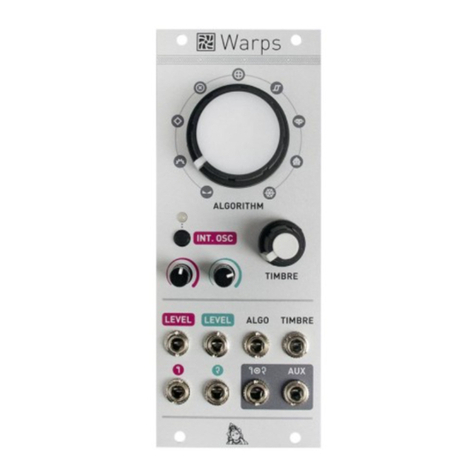
Mutable Instruments
Mutable Instruments Warps user manual
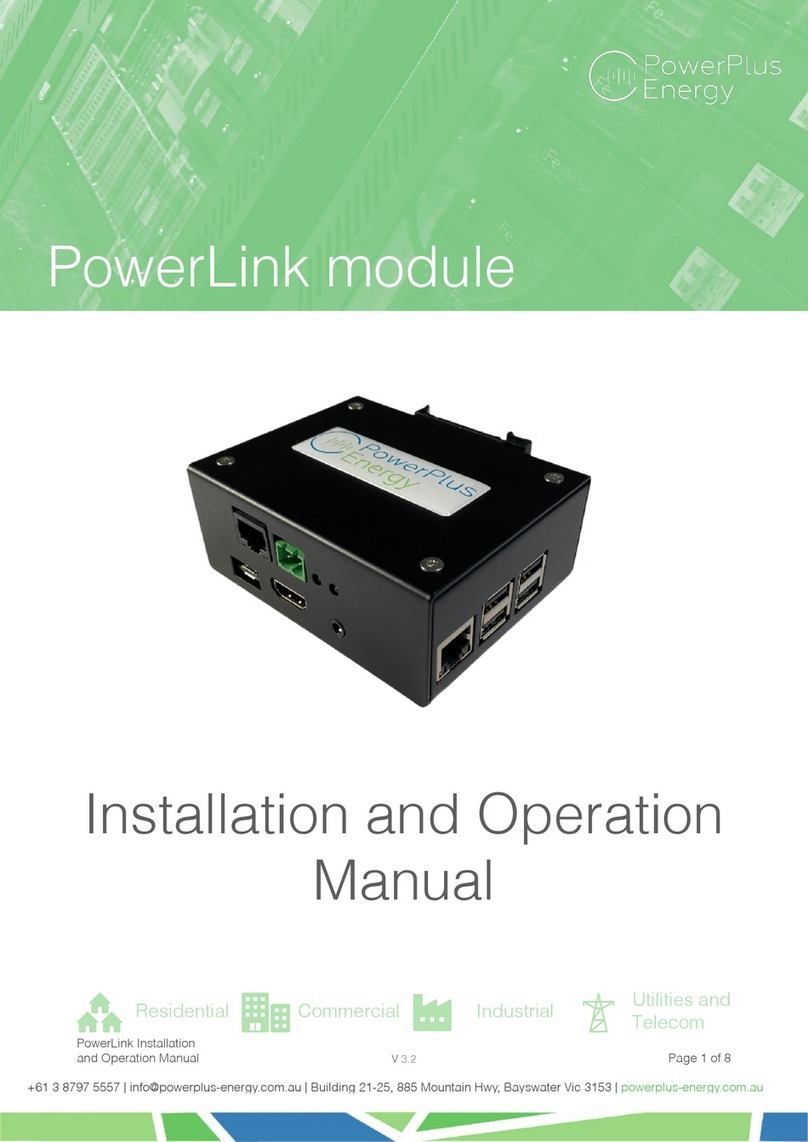
PowerPlus Energy
PowerPlus Energy PowerLink Installation and operation manual
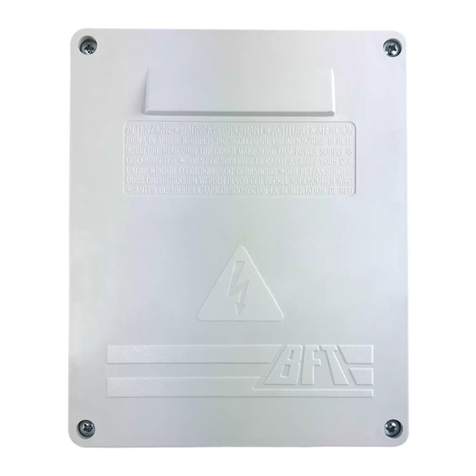
BFT
BFT ALCOR UL Installation and user manual
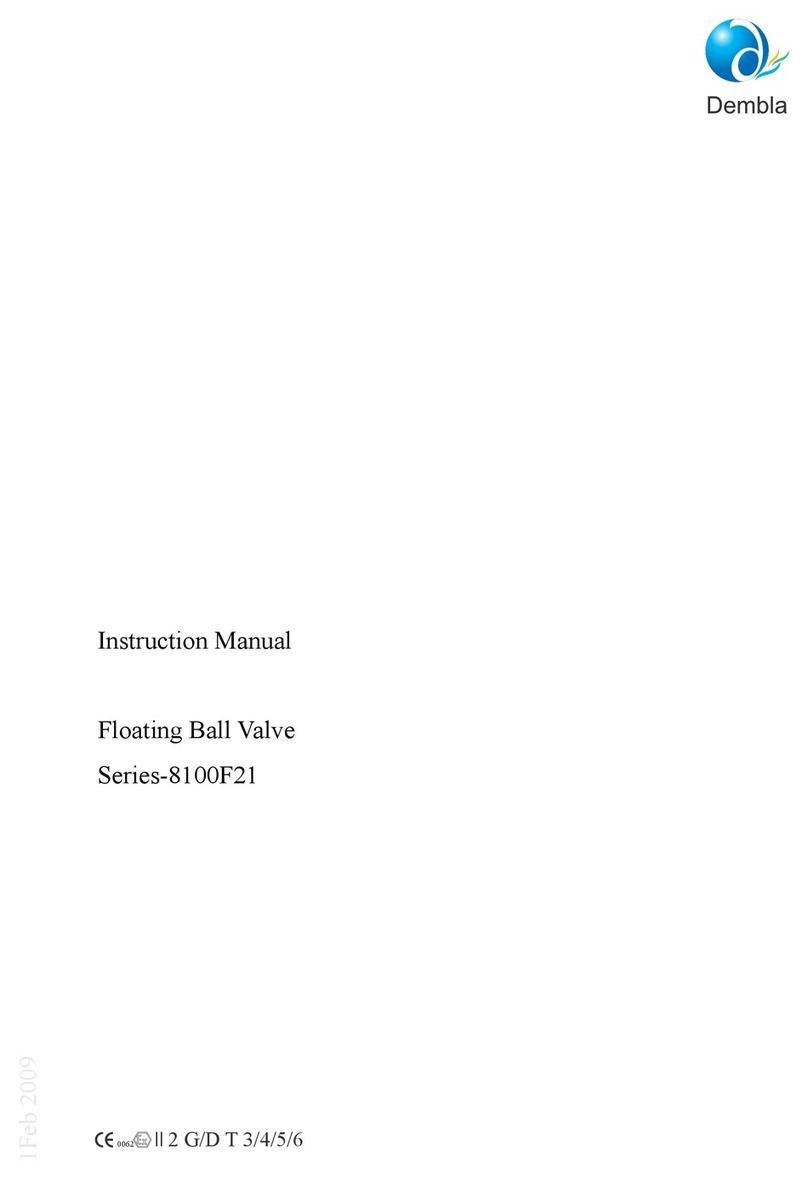
Dembla
Dembla 8100F21 Series instruction manual

Pulsar
Pulsar MSR 1512 quick start guide



